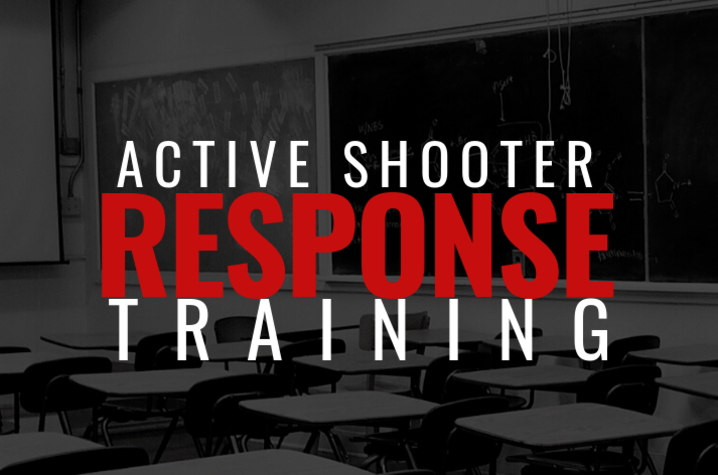Ideal Practices for Carrying Out Active Shooter Training in Your Company
Ideal Practices for Carrying Out Active Shooter Training in Your Company
Blog Article
Discovering the Secret Parts and Purposes of Effective Active Shooter Training Programs
Active shooter training programs are essential in equipping people and companies with the necessary skills to respond successfully to possible dangers. These programs integrate important parts, such as the "Run, Hide, Battle" method, realistic scenario simulations, and interaction methods, fostering an atmosphere of preparedness. They highlight mental durability to help participants browse high-stress situations. As we discover the ins and outs of these training programs, it ends up being evident that recognizing their thorough nature is crucial to enhancing precaution and action capabilities. What specific aspects genuinely define their effectiveness?
Value of Active Shooter Training
Active shooter training programs are essential for boosting readiness and feedback in the face of potential dangers. These programs intend to outfit people, organizations, and areas with the knowledge and abilities essential to successfully react to active shooter scenarios. The raising frequency and severity of such cases underscore the relevance of positive actions, as prompt and enlightened actions can substantially alleviate harm.
Additionally, active shooter training promotes a culture of security and recognition within institutions, whether they be schools, work environments, or public venues. Participants discover to recognize early caution indicators and recognize the relevance of communication and synergy during emergency situations. This training not just highlights specific safety and security however additionally advertises a cumulative obligation to secure others.
Additionally, these programs can help reduce the anxiety and fear that commonly come with conversations regarding prospective hazards. By supplying structured assistance and sensible methods, people acquire self-confidence in their ability to react appropriately. Inevitably, the significance of energetic shooter training depends on its potential to conserve lives, minimize injuries, and cultivate a ready and durable area efficient in encountering unpredicted difficulties.
Key Parts of Training Programs
Reliable active shooter training programs normally integrate a number of vital components developed to prepare individuals for real-world circumstances. The very first part is comprehensive education on the nature of active shooter incidents, consisting of stats, study, and psychological factors that influence assailants. This academic structure is important for cultivating recognition and understanding among individuals.
Following, programs typically include training on individual safety steps, stressing the "Run, Hide, Fight" technique. Participants find out exactly how to analyze their setting, make fast choices, and take ideal activities during a crisis. Furthermore, the addition of effective interaction skills is vital, as individuals should understand how to report incidents and share essential details with police.
An additional necessary element is the involvement of regulation enforcement or protection experts, who supply understandings into tactical actions and the relevance of collaboration during a situation. In addition, programs need to address the mental results of an energetic shooter circumstance, using methods for coping and recovery.
Finally, ongoing training and correspondence course are essential to ensure that expertise continues to be existing and participants feel great in their capabilities. With each other, these essential parts develop an all-round training program that gears up individuals to respond efficiently to an energetic shooter occasion.
Realistic Scenario Simulations
Realistic situation simulations are a vital facet of energetic shooter training programs, providing individuals with the chance to participate in hands-on practice that mirrors possible real-life scenarios. These simulations improve the training experience by developing an immersive environment where individuals can apply academic expertise in practical settings.
With using role-playing, simulated situations, and specialized training centers, participants experience the prompt difficulties and stress factors connected with an energetic shooter event. This technique of training advertises quick decision-making, team effort, and the application of safety procedures under pressure. It enables -responders to develop vital abilities such as situational awareness, risk analysis, and effective evacuation procedures.
In addition, practical simulations assist to identify prospective weaknesses in participants' feedbacks, allowing instructors to offer targeted responses and enhance overall readiness. The unification of varying situations, including different locations and assaulter accounts, additionally enriches the training experience, making sure that individuals are well-equipped to take care of a variety of prospective situations.
Eventually, these simulations serve not just to instruct yet also to construct self-confidence among participants, cultivating a feeling of readiness that is essential for efficient emergency situation response despite an active shooter threat.
Interaction Methods in Training
Clear interaction is essential in active shooter training programs, as it straight influences the effectiveness of action initiatives throughout a crisis. active shooter training. Training participants must comprehend the procedures and procedures that will guide their actions if confronted with an energetic shooter situation. Developing clear lines of communication guarantees that all individuals involved can relay information quickly and precisely

In addition, training programs should highlight the significance of energetic listening. Individuals must be trained to interpret and react to details efficiently, decreasing misconceptions that can bring about harmful scenarios. Regular comments sessions post-training can likewise improve communication techniques, ensuring that all participants really feel equipped to share their experiences and ideas for renovation. Ultimately, efficient interaction strategies are essential for preparing individuals to react emphatically and cohesively when faced with an energetic shooter occurrence.

Mental Preparedness Strategies
Mental preparedness techniques are significantly identified as necessary components of energetic shooter training programs - active shooter training. These methods intend to gear up individuals with the psychological strength required to react properly in high-stress situations. By fostering an attitude in harmony with prospective threats, individuals can much better manage fear, anxiety, and complication throughout vital cases
Key mental preparedness approaches include scenario-based training and tension inoculation exercises. Scenario-based training submerses individuals in realistic simulations that mimic the turmoil of an energetic shooter event, allowing them to exercise decision-making under stress. This direct exposure helps develop familiarity with emergency situation procedures, enhancing instinctual responses.
Anxiety shot includes progressive direct exposure to stress-inducing situations, permitting individuals to develop coping systems. This can consist of breathing exercises, visualization methods, and cognitive restructuring to reframe negative ideas. By incorporating these strategies, training programs can cultivate a feeling of self-confidence and control, which is vital in situation circumstances.
In addition, post-incident emotional support is important to deal with the psychological after-effects of an active shooter occasion. Including psychological health sources about his right into training programs not just prepares individuals for instant reactions but additionally promotes long-term psychological health, ultimately adding to a more secure and much more resistant atmosphere.
Verdict
Finally, efficient active shooter training programs are vital for enhancing preparedness and action capabilities despite prospective threats. By including critical parts such as realistic scenario simulations, interaction techniques, and emotional preparedness techniques, these programs outfit individuals and companies with the needed abilities to browse high-stress circumstances. Ultimately, a thorough approach to training fosters strength and advertises a society of security, therefore adding to the general protection of areas in the occasion of an active shooter occurrence.
Report this page